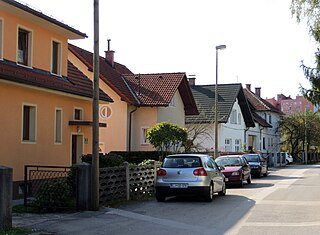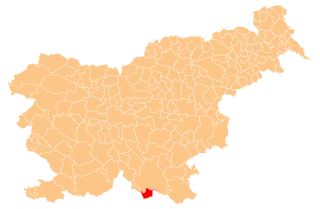
Sebenje is a settlement in the Municipality of Tržič in the Upper Carniola region of Slovenia.

Volčje is a village in the hills north of Brežice in the Municipality of Brežice in eastern Slovenia. The area was traditionally part of Styria. It is now included with the rest of the municipality in the Lower Sava Statistical Region.

Bistrica is a small settlement in the hills west of Črnomelj in the White Carniola area of southeastern Slovenia. The area is part of the traditional region of Lower Carniola and is now included in the Southeast Slovenia Statistical Region. It is located on a rocky terrace with sinkholes along the road from Črnomelj to the Poljane Valley.

Primoži is a small settlement in the Municipality of Kočevje in southern Slovenia. The area is part of the traditional region of Lower Carniola and is now included in the Southeast Slovenia Statistical Region.

Zdenska Vas is a village north of Videm in the Municipality of Dobrepolje in Slovenia. The area is part of the historical region of Lower Carniola. The municipality is now included in the Central Slovenia Statistical Region.

Studeno is a remote abandoned settlement in the Municipality of Kočevje in southern Slovenia. The area is part of the traditional region of Lower Carniola and is now included in the Southeast Slovenia Statistical Region. Its territory is now part of the village of Knežja Lipa.

Gače is a remote abandoned settlement in the Municipality of Semič in southern Slovenia. The area is part of the traditional region of Lower Carniola and is now included in the Southeast Slovenia Statistical Region. Its territory is now part of the village of Komarna Vas and it is registered as a cultural heritage site.

Muha Vas is a village in the Municipality of Kočevje in southern Slovenia. The area is part of the traditional region of Lower Carniola and is now included in the Southeast Slovenia Statistical Region. It no longer has any permanent residents.

Kuhlarji is a village in the Municipality of Kočevje in southern Slovenia. The area is part of the traditional region of Lower Carniola and is now included in the Southeast Slovenia Statistical Region. It no longer has any permanent residents.

Kunč is a remote abandoned settlement in the Municipality of Dolenjske Toplice in southern Slovenia. The area is part of the traditional region of Lower Carniola and is now included in the Southeast Slovenia Statistical Region. Its territory is now part of the village of Podstenice. Northeast of Kunč there is an ice-filled cave called Ice Cave. It is connected to Kunč by a path and people would go to the cave for ice during times of drought.

Lahinja is a remote abandoned settlement in the Municipality of Semič in southern Slovenia. The area is part of the traditional region of Lower Carniola and is now included in the Southeast Slovenia Statistical Region. Its territory is now part of the village of Planina.

Dolenja Žaga is an abandoned settlement on the left bank of the Kolpa River north of Kostel in southern Slovenia. The area is part of the traditional region of Lower Carniola and is now included in the Southeast Slovenia Statistical Region. It includes the hamlets of Lobič, Na Rebri, and Trsje.

Glinica is a former settlement in central Slovenia in the northwest part of the capital Ljubljana. It belongs to the Dravlje District of the City Municipality of Ljubljana. It was part of the traditional region of Upper Carniola and is now included with the rest of the municipality in the Central Slovenia Statistical Region.

Zapuže is a former settlement in central Slovenia in the northwest part of the capital Ljubljana. It belongs to the Dravlje District of the City Municipality of Ljubljana. It was part of the traditional region of Upper Carniola and is now included with the rest of the municipality in the Central Slovenia Statistical Region.

Trata is a former settlement in central Slovenia in the northwest part of the capital Ljubljana. It belongs to the Šentvid District of the City Municipality of Ljubljana. It was part of the traditional region of Upper Carniola and is now included with the rest of the municipality in the Central Slovenia Statistical Region.

Kamna Gorica is a former settlement in central Slovenia in the northwest part of the capital Ljubljana. It belongs to the Dravlje District of the City Municipality of Ljubljana. It was part of the traditional region of Upper Carniola and is now included with the rest of the municipality in the Central Slovenia Statistical Region.

Pržan is a former settlement in central Slovenia in the northwest part of the capital Ljubljana. It belongs to the Šentvid District of the City Municipality of Ljubljana. It was part of the traditional region of Upper Carniola and is now included with the rest of the municipality in the Central Slovenia Statistical Region.

Brod is a formerly independent settlement in the northern part of the capital Ljubljana in central Slovenia. It was part of the traditional region of Upper Carniola and is now included with the rest of the municipality in the Central Slovenia Statistical Region.

Brod is a formerly independent settlement in the northern part of the capital Ljubljana in central Slovenia. It was part of the traditional region of Upper Carniola and is now included with the rest of the municipality in the Central Slovenia Statistical Region.

Kuželič is a small uninhabited settlement west of Vas in the Municipality of Kostel in southern Slovenia. The area is part of the traditional region of Lower Carniola and is now included in the Southeast Slovenia Statistical Region.











